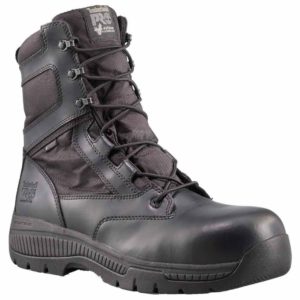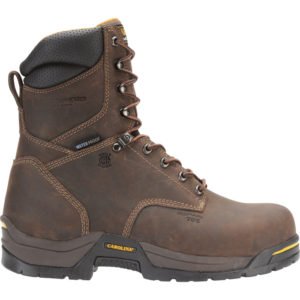The Ultimate Guide to the Best Climbing Boots for Lineman
![best climbing boots for lineman [featured image] text which has an image of a lineman climbing up a pole with a white helmet and tools around his waist.](https://www.bestworkbootsideas.com/wp-content/uploads/2023/08/best-climbing-boots-for-lineman-featured-image.jpg)
Welcome to the ultimate guide to the best climbing boots for linemen!
If you’ve ever wondered what makes a boot perfect for those high-climbing, electricity-wrangling heroes we call linemen, you’re in the right place.
Whether you’re a seasoned lineman yourself or just curious about the gear these professionals trust their lives with, we’ve got you covered.
In this comprehensive guide, we’ll delve into the nitty-gritty of what makes a lineman boot stand out from your regular work boot.
We’ll explore the key features to look for, the top brands that linemen swear by and even how to care for and maintain these boots to ensure they last.
We’ll also tackle some of the most frequently asked questions about lineman boots, from safety standards to vegan options.
So, strap in (or should we say, lace up!) and get ready for a deep dive into the world of lineman climbing boots. It’s going to be a thrilling climb!
Contents
Summary Table
| Topic | Key Points |
| Key Features | Traction, ankle support, comfort, durability, waterproof |
| Differences from Regular Work Boots | Special design for climbing, high shaft, durable materials, lace-to-toe design, electrical hazard protection |
| Top Brands | Red Wing, Carolina, Wesco, La Sportiva, Chippewa |
| Maintenance and Care | Regular cleaning, natural drying, conditioning, proper storage, regular inspection |
| Safety Standards | Electrical Hazard (EH) rating, slip resistance rating, impact and compression resistance |
| Buying Online | Measure foot, check size chart, read customer reviews, consider socks, choose a retailer with a good return policy |
| Price Range | $150 – $400 |
| Lifespan | 1 – 3 years with regular use and proper care |
| Resoling | Possible with certain boot constructions |
| Vegan Options | Available, made with synthetic materials |
What are the key features to look for in the best climbing boots for lineman?
When it comes to choosing the best climbing boots for lineman, there are several key features to consider.
First and foremost, the boots should provide excellent traction to ensure safety while climbing.
This can be achieved through deep lugs and a non-slip sole.
Secondly, the boots should offer good ankle support. This is crucial as linemen often work in challenging environments and need to maintain balance while climbing.
A boot with a high shaft can provide this support.
Comfort is another important aspect. Linemen spend long hours on their feet, so the boots should have a comfortable insole and fit well.
A padded collar and tongue can add to the comfort level.
Durability is also a key feature. The boots should be made of high-quality materials to withstand the harsh conditions of lineman work.
Leather is a popular choice due to its durability and resistance to wear and tear.
Finally, the boots should be waterproof to keep the feet dry in wet conditions.
Some boots also offer additional features like electrical hazard protection, which can be beneficial for linemen.
Key Features and Their Benefits
| Feature | Benefit |
| Excellent Traction | Ensures safety while climbing by preventing slips and falls. |
| Good Ankle Support | Provides stability and balance, reducing the risk of ankle injuries. |
| Comfortable Fit | Reduces foot fatigue during long hours of work. |
| Durable Materials | Withstands harsh conditions, making the boots last longer. |
| Waterproof | Keeps feet dry in wet conditions, enhancing comfort and preventing potential foot problems. |
Top 5 Lineman Climbing Boots
- Red Wing Lineman Boots
- Carolina 8″ Steel Toe Loggers
- Wesco Highliner Boots
- La Sportiva Makalu Mountaineering Boot
- Chippewa Men’s 9″ Waterproof Insulated Steel-Toe EH Logger Boot
Red Wing Lineman Boots
Red Wing is a brand synonymous with quality and durability, and their lineman boots are no exception.
Made with premium leather for longevity, these boots offer excellent traction for safe climbing – a feature linemen will appreciate when they’re up high on poles or towers!
The comfortable fit ensures you can wear them all day without discomfort, while the waterproof feature keeps your feet dry in any weather.
Carolina 8″ Steel Toe Loggers
Carolina’s steel toe loggers are designed with the needs of linemen in mind – from the high ankle support to the electrical hazard rating for added safety when working with electricity.
The aggressive tread pattern provides superior traction, while the steel toe offers protection against falling objects or compression hazards.
Wesco Highliner Boots
Wesco Highliner boots are known for their robust construction that can withstand even the harshest conditions of lineman work.
They feature a high shaft for better ankle support and a lace-to-toe design that allows for a more customized fit – ensuring comfort throughout your workday.
La Sportiva Makalu Mountaineering Boot
La Sportiva’s Makalu Mountaineering boot is lightweight yet durable – perfect for those long climbs!
It offers excellent grip on various surfaces due to its Vibram sole, ensuring safe climbing every time.
Chippewa Men’s 9″ Waterproof Insulated Steel-Toe EH Logger Boot
Chippewa’s logger boot combines functionality with comfort perfectly!
Its waterproof feature ensures dry feet in wet conditions while its insulation keeps your feet warm during cold days out in the field.
How do lineman boots differ from regular work boots?
Lineman boots are specifically designed to meet the unique needs of linemen.
Unlike regular work boots, they have a special design that provides extra support and stability for climbing.
The soles of lineman boots are typically made of thick rubber to provide excellent traction.
They also have a steel shank for added support.
This is particularly important for linemen as they need to maintain balance while climbing poles or towers.
In addition, lineman boots often have a high shaft for better ankle support.
They are also usually made of durable materials like leather to withstand the harsh conditions of lineman work.
Another distinctive feature of lineman boots is their lacing system.
They often have a lace-to-toe design, which allows for a more customized fit.
This can help to enhance comfort and reduce the risk of foot fatigue.
Lastly, many lineman boots offer electrical hazard protection.
This is a crucial feature as linemen often work with electricity.
What are the top brands for lineman climbing boots?
There are several brands that are known for producing high-quality lineman climbing boots. These include:
- Red Wing: Red Wing is a renowned brand that offers a range of lineman boots. Their boots are known for their durability, comfort, and excellent traction.
- Carolina: Carolina is another popular brand among linemen. They offer boots with special features like electrical hazard protection and a steel shank for added support.
- Wesco: Wesco is a brand that specializes in work boots. Their lineman boots are highly rated for their quality and durability.
- La Sportiva: La Sportiva is a well-known brand in the climbing community. Their lineman boots are praised for their lightweight design and excellent grip.
- Chippewa: Chippewa is a reputable brand that offers a variety of work boots. Their lineman boots are known for their robust construction and comfort.
How to maintain and care for lineman climbing boots?
Proper maintenance and care can significantly extend the lifespan of lineman climbing boots. Here are some tips:
- Cleaning: After each use, remove any dirt or debris from the boots. Use a soft brush or damp cloth for cleaning. Avoid using harsh chemicals as they can damage the material.
- Drying: If the boots get wet, let them dry naturally. Avoid placing them near a heat source as it can cause the material to crack.
- Conditioning: Regularly condition the boots to keep the leather soft and prevent it from drying out. Use a quality leather conditioner for this purpose.
- Storage: Store the boots in a cool, dry place. Avoid storing them in direct sunlight or in a damp area.
- Inspection: Regularly inspect the boots for any signs of wear and tear. If you notice any damage, get it repaired immediately to prevent it from worsening.
Are there specific safety standards for lineman climbing boots?
Yes, there are specific safety standards for lineman climbing boots.
These standards are set by organizations like the American Society for Testing and Materials (ASTM).
One of the key standards is the Electrical Hazard (EH) rating.
This indicates that the boots provide protection against electrical shocks.
It is a crucial feature for linemen as they often work with electricity.
Another important standard is the slip resistance rating.
This indicates the level of traction provided by the boots.
Good traction is essential for linemen to maintain balance while climbing.
Some lineman boots also meet the standards for impact and compression resistance.
These features provide protection against falling objects and crushing hazards.
How to ensure the right fit when buying lineman climbing boots online?
Buying lineman climbing boots online can be a bit challenging due to sizing issues.
However, there are several steps you can take to ensure the right fit:
- Measure your foot: Use a ruler or a measuring tape to measure the length and width of your foot. It’s best to do this at the end of the day when your feet are at their largest.
- Check the size chart: Most online retailers provide a size chart. Compare your measurements with the size chart to determine the right size.
- Read customer reviews: Customer reviews can provide valuable insights about the fit of the boots. Look for comments about whether the boots run large or small.
- Consider the socks: If you plan to wear thick socks with the boots, consider going a half size up.
- Choose a retailer with a good return policy: In case the boots don’t fit, you should be able to return or exchange them without hassle.
What is the average price range for lineman climbing boots?
The price of lineman climbing boots can vary widely depending on the brand, quality, and features.
On average, you can expect to pay between $150 and $400 for a pair of good-quality lineman climbing boots.
While it might be tempting to go for cheaper options, it’s important to remember that you get what you pay for.
Investing in a pair of high-quality boots can provide better comfort, safety, and durability in the long run.
How long do lineman climbing boots typically last?
The lifespan of lineman climbing boots depends on several factors including the quality of the boots, how often they are used, and how well they are maintained.
On average, a pair of high-quality lineman climbing boots can last anywhere from 1 to 3 years with regular use.
However, with proper care and maintenance, they can last even longer.
It’s important to regularly inspect the boots for any signs of wear and tear.
If the soles are worn out or the boots are no longer providing adequate support and comfort, it’s time to replace them.
Can lineman climbing boots be resoled?
Yes, many lineman climbing boots can be resoled.
This can significantly extend the lifespan of the boots and save you money in the long run.
However, not all boots are resoleable. Whether or not a boot can be resoled depends on its construction.
Boots with a Goodyear welt or stitch-down construction are typically resoleable.
If you’re considering buying a pair of lineman climbing boots and want the option to resole them in the future, it’s best to check with the manufacturer or retailer before making a purchase.
Are there vegan options for lineman climbing boots?
Yes, there are vegan options for lineman climbing boots. These boots are made without any animal products or by-products.
Instead, they use synthetic materials that mimic the properties of leather.
However, it’s important to note that vegan boots may not offer the same level of durability as leather boots.
They may also require different care and maintenance.
When choosing vegan lineman climbing boots, look for options that offer the same key features as non-vegan boots, such as excellent traction, good ankle support, comfort, and durability.
It’s also a good idea to read customer reviews to get an idea of the boots’ performance and quality.
How can I break in my new lineman climbing boots?
Breaking in new lineman climbing boots is an essential step to ensure comfort and prevent blisters. Here are some tips:
- Start by wearing them indoors: Before you start climbing with your new boots, wear them around the house for a few days. This will help to soften the material and mold it to the shape of your feet.
- Wear the right socks: Wear the same type of socks that you plan to wear while climbing. This will help to ensure a proper fit.
- Gradually increase wearing time: Don’t wear your new boots for a full day of climbing right away. Start with short periods of wear and gradually increase the time as your feet get used to the boots.
- Use a leather conditioner: Applying a leather conditioner can help to soften the material and speed up the break-in process. However, make sure to test the conditioner on a small area first to ensure it doesn’t discolor the leather.
- Avoid getting them wet: While it might be tempting to soak your new boots in water to speed up the break-in process, this can actually damage the leather. It’s best to break in your boots naturally through wear.
Remember, it’s normal for new boots to feel a bit uncomfortable at first. However, if you’re experiencing severe discomfort or pain, it’s possible that the boots are not the right fit for you.
What are the differences between lineman boots and logger boots?
While lineman boots and logger boots may look similar, there are key differences between them due to the different nature of the work involved.
Lineman boots are designed for climbing and often have a smooth, one-piece sole for better grip on poles or towers.
They also typically have a higher shank for added ankle support and stability.
Some lineman boots also feature a built-in steel shank for extra support.
On the other hand, logger boots are designed for walking on uneven terrain and often have a more aggressive tread pattern for better traction.
They also typically have a heel, which can help to reduce the risk of slipping when walking on logs or other slippery surfaces.
For more detailed differences, you can check out this article on lineman boots vs logger boots.
How to choose the right size for lineman climbing boots?
Choosing the right size for lineman climbing boots is crucial for comfort and performance. Here are some tips:
- Measure your foot: Use a ruler or a measuring tape to measure the length and width of your foot. It’s best to do this at the end of the day when your feet are at their largest.
- Check the size chart: Most brands provide a size chart. Compare your measurements with the size chart to determine the right size.
- Consider the socks: If you plan to wear thick socks with the boots, consider going a half size up.
- Try them on: If possible, try on the boots before buying. They should fit snugly but not too tight. There should be enough room to wiggle your toes, but your heel should not slip when you walk.
Remember, the right size can vary between different brands and even different models within the same brand. It’s always a good idea to read customer reviews or ask the retailer for advice if you’re unsure.
What materials are lineman climbing boots typically made of?
Lineman climbing boots are typically made of durable materials that can withstand the harsh conditions of lineman work.
The most common material is leather, due to its durability and resistance to wear and tear.
The soles of lineman boots are usually made of rubber for excellent traction.
Some boots also have a steel shank for added support.
In addition, many lineman boots feature a waterproof membrane to keep the feet dry in wet conditions.
Some boots also offer additional features like insulation for warmth, or a protective toe cap for safety.
It’s important to note that the type of material can affect the performance, comfort, and lifespan of the boots.
Therefore, it’s crucial to consider your specific needs and working conditions when choosing the material.
Are there any specific lacing techniques for lineman climbing boots?
Yes, there are specific lacing techniques for lineman climbing boots that can enhance comfort and support.
One popular technique is the “lace-to-toe” method.
In this method, the laces are threaded through all the eyelets from the toe to the top of the boot.
This allows for a more customized fit and better support, especially for climbing.
Another technique is the “heel lock” or “lace lock” method. This involves creating a loop with the laces at the second-to-last eyelets, then threading the laces through these loops before tying them.
This helps to secure the heel and prevent it from slipping, which can enhance stability and reduce the risk of blisters.
Remember, the right lacing technique can vary depending on the design of the boot and your personal comfort.
It’s always a good idea to experiment with different techniques to find what works best for you.
Brands to Consider
For Lineman, a number of popular brands include;
- Hoffman Boots – The company has a number of specialist boots for Lineman. Models include the Powerline, Dri-Line and Meindl to name a few.
- Canada West – Consider the 34316, 34396 and 34432 climbing models.
- Kenetrek – COnsider the Lineman Extreme models such as the Extreme NI ST and Extreme 1000 ST.
- White’s Boots – If you have a high budget then the Lineman Pro is a good option. However, at the cost of almost 3x a normal work boot, this may be out of most people’s price range.
Wrapping Up
In conclusion, choosing the best climbing boots for linemen involves considering several key features.
These include excellent traction for safe climbing, good ankle support for balance, comfort for long hours of wear, durability to withstand harsh conditions, and waterproof capabilities for wet environments.
Some boots also offer additional features like electrical hazard protection, which is beneficial for linemen.
The boots differ from regular work boots in their design, offering extra support and stability for climbing.
They often feature a high shaft, durable materials like leather, and a lace-to-toe design for a more customized fit.
Top brands known for producing high-quality lineman climbing boots include Red Wing, Carolina, Wesco, La Sportiva, and Chippewa.
Maintenance and care of these boots are crucial for their longevity.
Regular cleaning, natural drying, conditioning, proper storage, and regular inspection can significantly extend their lifespan.
It’s also important to note that there are specific safety standards for lineman climbing boots, such as the Electrical Hazard (EH) rating and slip resistance rating.
When buying lineman climbing boots online, ensure the right fit by measuring your foot, checking the size chart, reading customer reviews, considering the type of socks you plan to wear, and choosing a retailer with a good return policy.
The average price range for these boots is between $150 and $400, and with proper care, they can last anywhere from 1 to 3 years.
Whether you’re a seasoned lineman or just starting in the profession, investing in a pair of high-quality climbing boots can significantly enhance your safety, performance, and comfort on the job.







